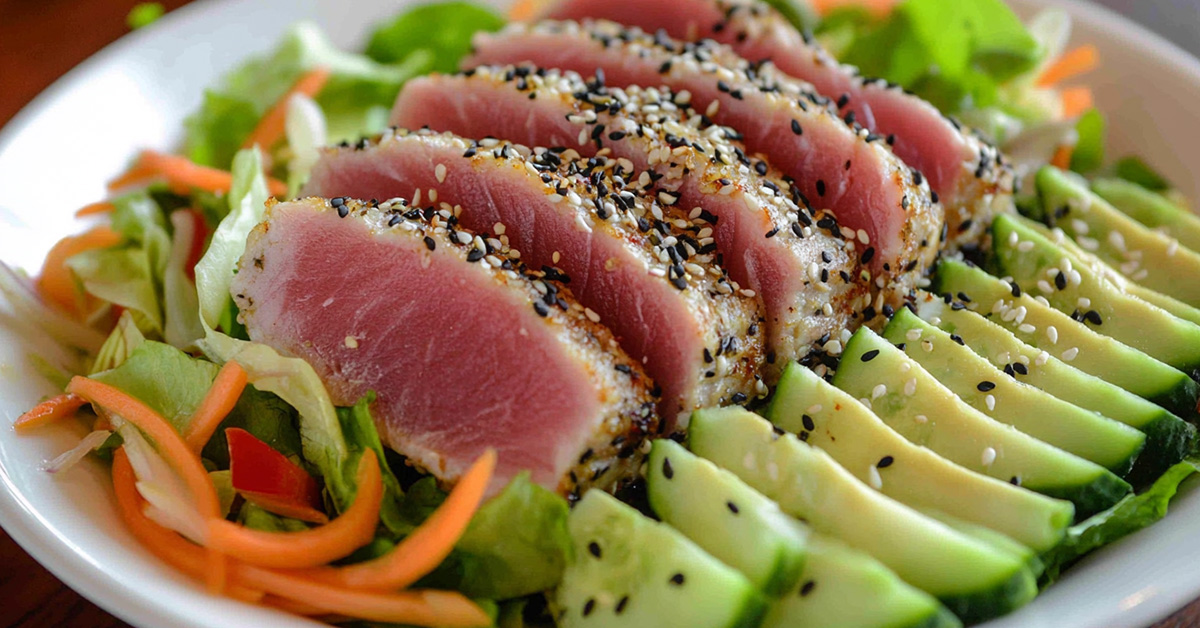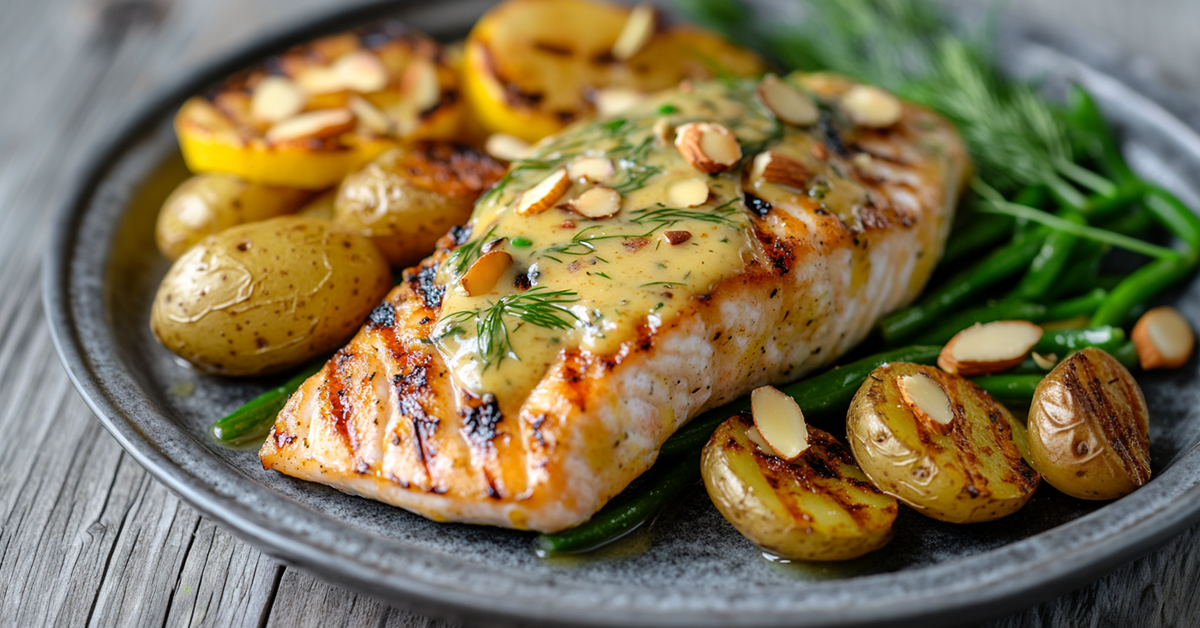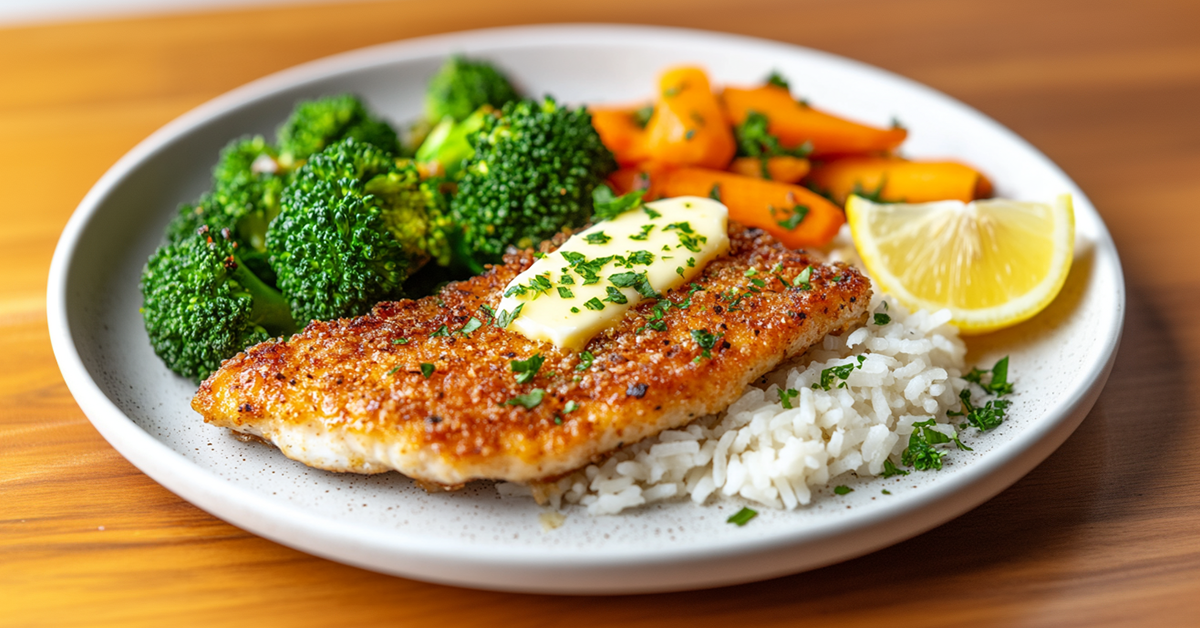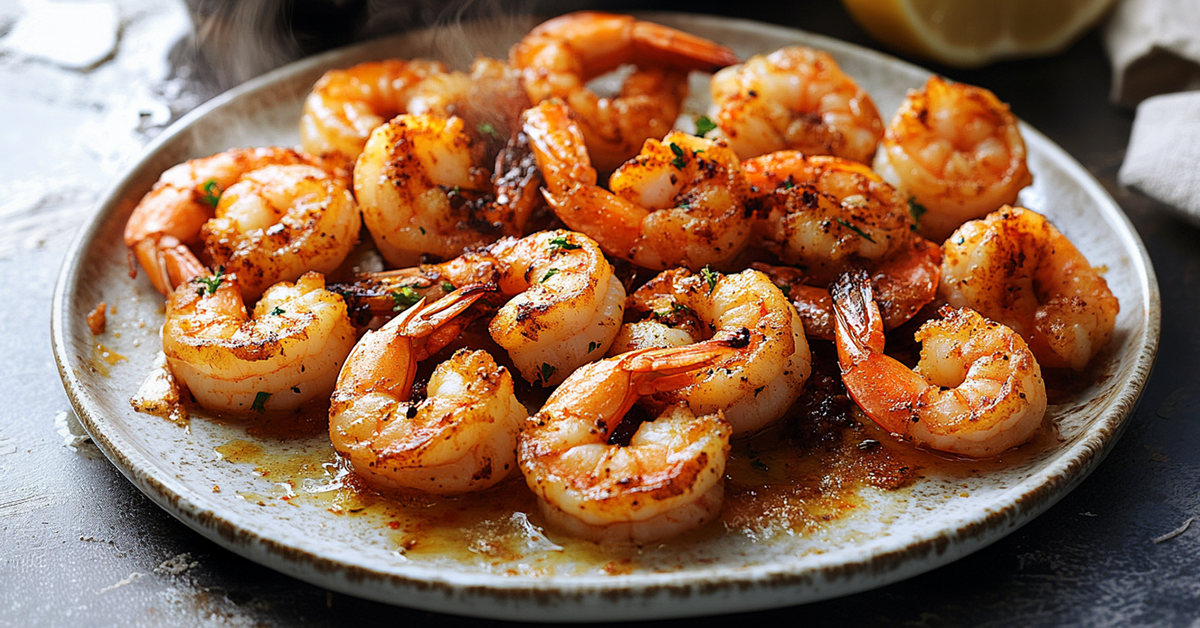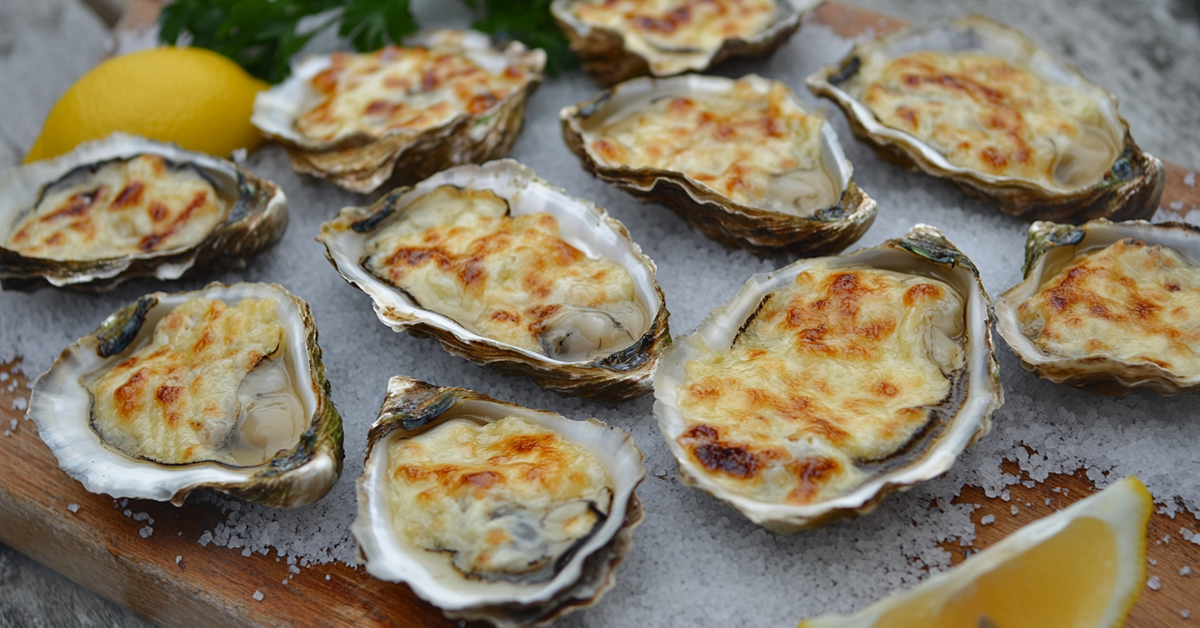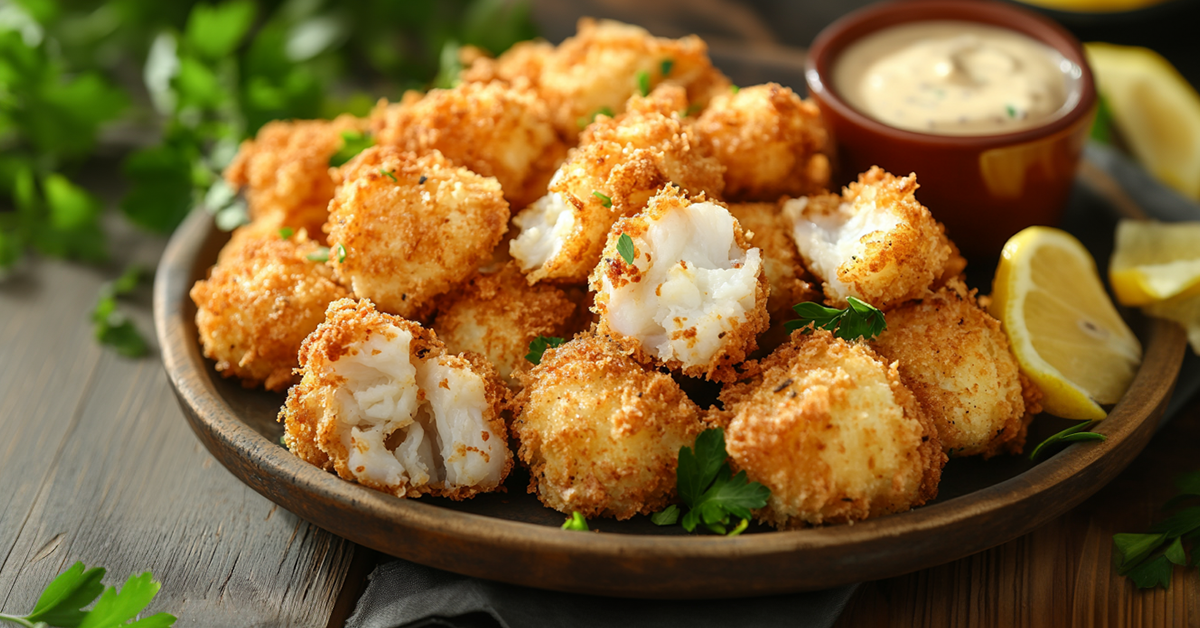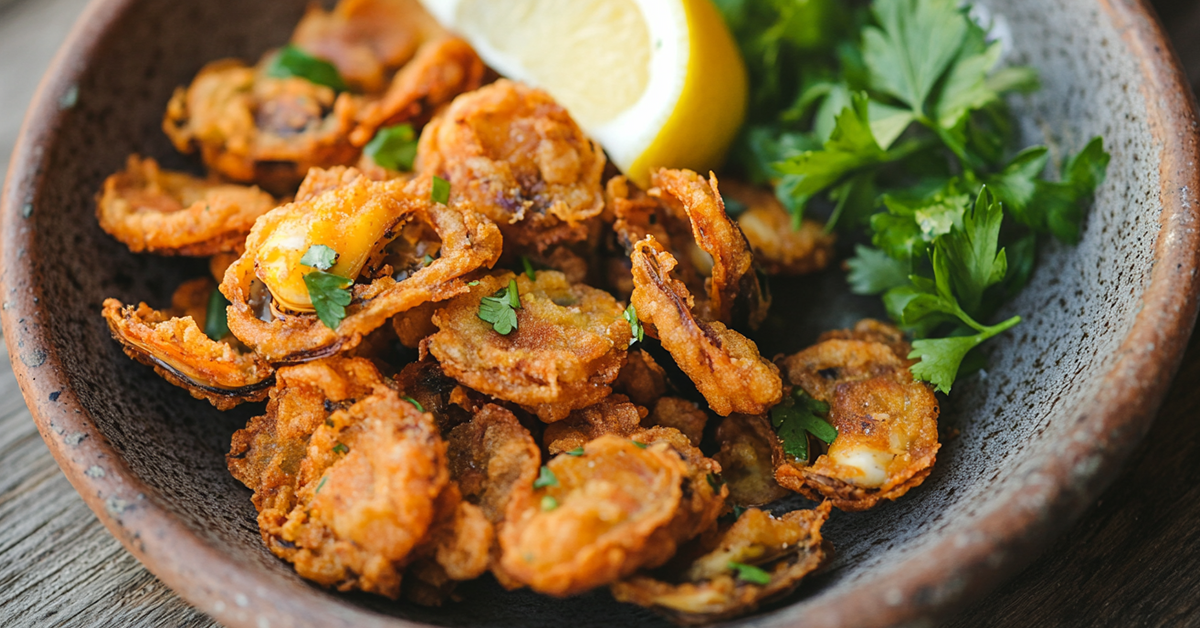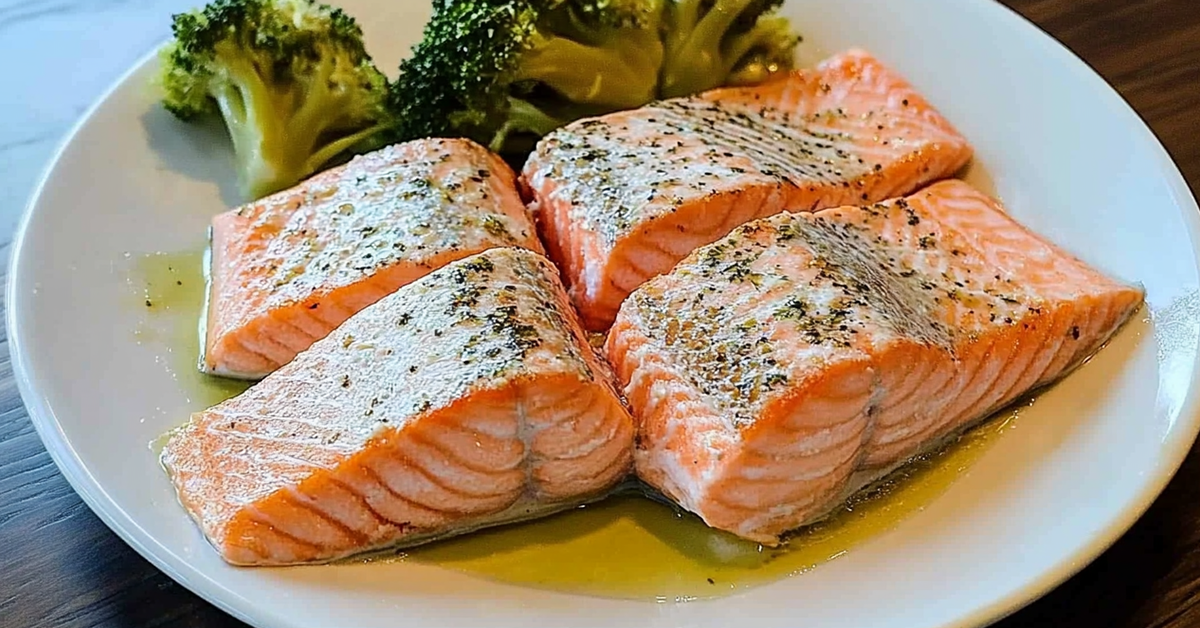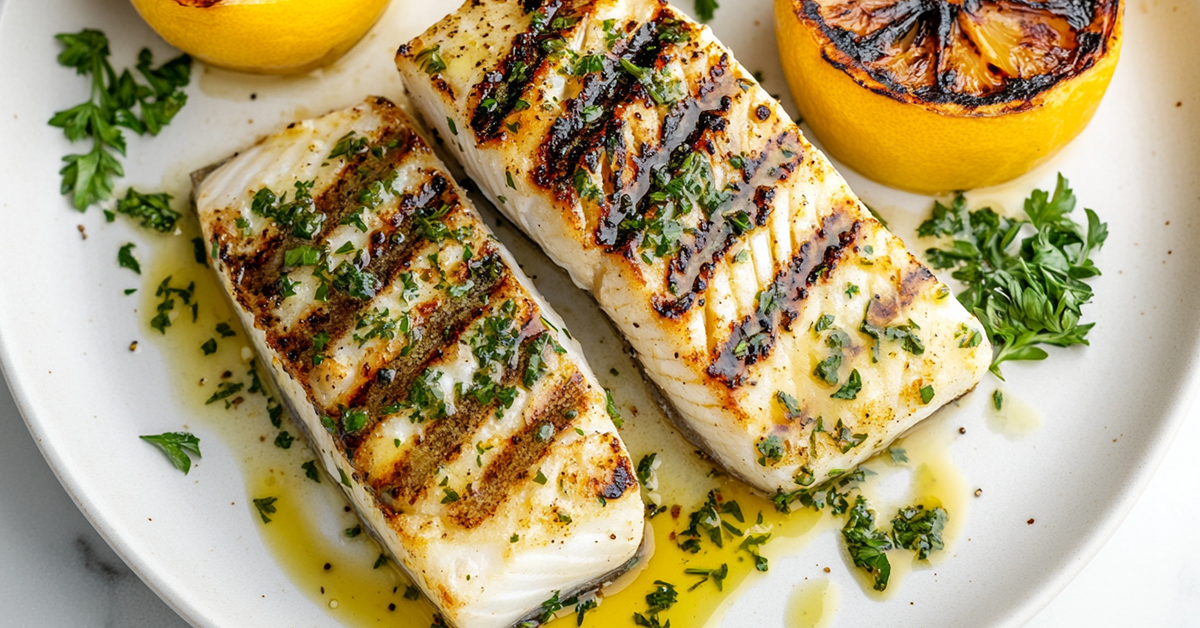Did you know that the average American spends 37 minutes preparing dinner each night?
A restaurant-quality meal could be yours in less time. This ahi salad recipe combines protein-rich tuna and fresh vegetables that you can prepare in minutes, not hours.
Seared ahi tuna remains pink in the middle and rests on a bed of crisp greens with a zesty Asian-inspired dressing. This ahi tuna salad recipe is quick, easy and perfect for busy weeknights when you want something special without extra work.
This piece will help you create the perfect ahi salad, regardless of your cooking expertise. You’ll learn everything from selecting the freshest tuna to becoming skilled at getting the perfect sear.
Ready to raise your dinner game? Let’s explore!
Table of Contents
Understanding Ahi Tuna: A Culinary Delight
Ahi tuna stands out as a true culinary gem in the premium seafood world. The term “Ahi,” meaning “fire” in Hawaiian, covers both yellowfin and bigeye tuna varieties. This knowledge becomes crucial as you start to prepare your own ahi salad recipes.
Ahi tuna’s special appeal comes from its remarkable versatility and unique traits. The flesh shows a beautiful deep red color in its raw state and changes to a tan shade after cooking. You’ll notice Ahi’s firm, meaty texture and mild, clean flavor that many people call buttery.
Premium Ahi tuna’s key qualities are worth noting:
- Deep red coloration showing freshness.
- Firm, dense texture perfect for various preparations.
- Clean, mild flavor that pairs well with a variety of seasonings.
- Superior quality from tropical and subtropical waters.
Ahi tuna really shines through its versatility in preparation. Raw preparations like sashimi and poke showcase its excellence, and it tastes just as amazing when seared, grilled, or pan-fried. Best results come from minimal cooking – serve the fish rare to medium-rare to keep its delicate flavor and texture intact.
Ahi holds deep cultural roots, especially in Hawaiian cuisine. Beyond mere food, it symbolized prosperity and strength in Hawaiian culture historically. Modern chefs celebrate this prestigious fish in both traditional and contemporary dishes.
Quality matters most when choosing Ahi tuna. Raw or rare preparations need sushi or sashimi-grade tuna from reputable sources. Premium Ahi goes into ultra-low temperature freezers within an hour of catching to preserve its freshness and unique characteristics.
Your Ahi salad recipe preparation should note that this fish delivers more than great taste. Ahi tuna packs lean protein, omega-3 fatty acids, and essential nutrients like vitamin B12, magnesium, and phosphorus.
Selecting the Best Ahi Tuna for Your Salad Recipe
Quality indicators play a crucial role in picking the perfect ahi tuna for your salad. At the time you choose between fresh or frozen tuna, quality becomes the deciding factor. In stark comparison to this common belief, frozen tuna can be just as high-quality as fresh with proper handling.
Your ahi tuna selection should meet these quality markers:
- A vibrant red to pink color that’s translucent and shiny.
- Fresh, clean oceanic smell without any strong fishy odor.
- Firm, springy texture that responds to pressure.
- No brown discoloration or dry patches.
- Properly sealed packaging without tears.
Sushi-grade tuna provides the best safety and quality standards that meet strict criteria for raw consumption. The FDA hasn’t officially regulated the term “sushi-grade,” yet this label typically shows the fish meets FDA freezing guidelines to eliminate parasites.
Frozen tuna needs to be completely solid without signs of thawing and refreezing. Packages showing ice crystals might indicate temperature fluctuations, so avoid them. Your frozen tuna should go straight to the home freezer after purchase. If you plan to use it within two days, store it in your refrigerator at 40 degrees Fahrenheit.
Sustainability Matters Environmental responsibility should guide your ahi tuna sourcing decisions. Labels like “pole-caught,” “pole-and-line-caught,” or “troll-caught” indicate better fishing practices. These methods help preserve marine ecosystems. The Indian Ocean poses overfishing challenges for several species, so tuna from this region should be avoided.
Reputable seafood markets or retailers who prioritize quality and sustainability are a great way to get the best results for your ahi salad recipe. Premium markets often provide detailed information about their tuna’s origin and handling methods. Note that proper color doesn’t always indicate freshness – some suppliers use carbon monoxide to preserve color, so check the label for added artificial colors.
Proper storage helps maintain your carefully selected ahi tuna’s quality. Fresh tuna should be used within two days of purchase and kept refrigerated until salad preparation.
Essential Preparation Techniques for Ahi Tuna Salad
Learning to prepare an ahi salad recipe starts with proper food safety. The FDA has specific freezing guidelines that ensure your tuna’s safety: freeze at -4°F (-20°C) or below for 7 days, or at -31°F (-35°C) until solid and store at -31°F (-35°C) for 15 hours. [Refrence]
Essential Safety Tips:
- Buy tuna only from vendors who know fish handling well.
- Let frozen tuna thaw in the refrigerator instead of room temperature.
- Use clean, sanitized cutting boards and utensils.
- The fish should stay cold during preparation.
Here’s how to prepare your ahi tuna for salad:
- Skinning: Start at the tail end and slide your knife between skin and meat. The skin should come off cleanly as you push the knife forward.
- Cleaning: Clean your cutting board well after skinning to remove any scales and oils that might affect the taste.
- Bloodline Removal: Find the dark portion and cut it away with shallow, smooth strokes. This step keeps strong, fishy flavors out of your salad.
- Sinew Separation: Look for the white line in the fish. Remove it with gentle, angled cuts.
Temperature contrast plays a vital role in perfect ahi salad preparation. Cold tuna meeting a hot pan creates that beautiful outer sear while keeping a raw center. Cut the tuna against the grain into ¼-inch thick pieces. Use one smooth stroke instead of sawing motions.
A clean workspace makes a difference. Use a bleach solution to sanitize both sides of your cutting board, and dry with clean kitchen or paper towels. Handle the fish flesh as little as possible to keep pathogens away and preserve the flavor.
Pro Tip: Don’t worry about trimming mistakes if you’re new to ahi tuna preparation. These pieces work great in poke bowls or tuna tartare.
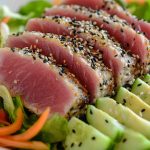
Ahi Salad Recipe
- Total Time: 30 minutes
- Yield: 4 servings 1x
Description
Make your kitchen feel like a gourmet bistro with this stunning ahi salad recipe. Seared tuna pairs beautifully with fresh, crisp vegetables and a tangy Asian-inspired dressing.
This eye-catching salad showcases perfectly seared ahi tuna on fresh mixed greens that went together with one another. Crisp vegetables and a zesty sesame ginger dressing complete this impressive yet simple dish. You can prepare it in minutes, making it perfect for casual lunches or elegant dinners.
Ingredients
To prepare the Tuna:
- 1 pound sushi-grade ahi tuna
- 3 tablespoons sesame seeds (black and white)
- Salt and pepper to taste
To make the Salad:
- 6 cups mixed salad greens
- 2 cups cucumber noodles
- 2 cups carrot noodles
- 1 cup sliced bell peppers
- 1 avocado, thinly sliced
- ½ cup wonton strips
To create the Dressing:
- 3 tablespoons soy sauce
- 2 tablespoons rice vinegar
- 2 tablespoons honey
- ¼ cup sesame oil
- 1 teaspoon minced fresh ginger
Instructions
- Prepare the Dressing: Mix all dressing ingredients in a jar and shake until well combined.
- Prep the Salad Base: Add greens to a large bowl and drizzle with half of the dressing.
- Sear the Tuna: Heat oil in a large skillet over medium-high heat. Sear tuna for 1-2 minutes per side for rare, or longer if desired.
- Assemble: Layer vegetables on the dressed greens. Add thinly sliced tuna over the vegetables.
- Finish: Add avocado slices and wonton strips. Pour remaining dressing.
Notes
The tuna tastes best when seared quickly – 30 seconds per side will give you a perfect rare center.
You can prepare the dressing 5 days ahead for faster assembly.
Your safety matters – use sushi-grade tuna from a trusted source.
- Prep Time: 25 minutes
- Cook Time: 5 minutes
- Category: Salads
Health Benefits of Ahi Tuna Salad
Ahi tuna salad not only tastes amazing but also provides exceptional health benefits. Nutritionists rate ahi tuna as a ‘superfood’ because it delivers powerful nutrition while staying low in calories.
Ahi tuna’s rich blend of essential nutrients makes it a perfect addition to your diet. Each serving gives you:
- Omega-3 fatty acids (DHA and EPA).
- Vitamins A, B2, B3, B6, B9, B12, and D.
- Essential minerals including iron, zinc, calcium, and selenium.
Eating four ounces of tuna two to three times weekly leads to impressive health outcomes like weight loss and reduced inflammation. Ahi tuna’s high protein content keeps you full longer, which helps with weight management.
Brain and Heart Health Benefits Ahi tuna consumption gives your cognitive function a major boost. Research with 40,000 participants revealed that women who ate multiple tuna servings weekly had up to a 68% lower risk of developing dry eye. Your ahi salad’s omega-3 fatty acids support brain health and improve memory and cognitive function.
Bone and Muscle Support This ahi salad recipe delivers substantial vitamin D – just 3 ounces provides 50% of your recommended daily intake. These nutrients, along with high protein content, help maintain strong bones and muscles. [Reference]
Important Safety Considerations The FDA suggests limiting tuna intake to two to three servings weekly, despite its many health benefits. Pregnant women or those planning pregnancy should pay extra attention to these guidelines because of mercury levels.
Your ahi tuna salad pairs well with colorful vegetables. This combination adds more antioxidants and fiber to the nutritional profile. Tuna’s selenium content (101% of daily value per serving) acts as an antioxidant that protects cells from damage.
The preparation method affects your ahi tuna salad’s nutritional value. You can get maximum health benefits and flavor by following the recipe’s guidelines carefully.
Essential Preparation Techniques for Ahi Tuna Salad
Learning to prepare an ahi salad recipe starts with proper food safety. The FDA has specific freezing guidelines that ensure your tuna’s safety: freeze at -4°F (-20°C) or below for 7 days, or at -31°F (-35°C) until solid and store at -31°F (-35°C) for 15 hours.
Essential Safety Tips:
- Buy tuna only from vendors who know fish handling well.
- Let frozen tuna thaw in the refrigerator instead of room temperature.
- Use clean, sanitized cutting boards and utensils.
- The fish should stay cold during preparation.
Here’s how to prepare your ahi tuna for salad:
- Skinning: Start at the tail end and slide your knife between skin and meat. The skin should come off cleanly as you push the knife forward.
- Cleaning: Clean your cutting board well after skinning to remove any scales and oils that might affect the taste.
- Bloodline Removal: Find the dark portion and cut it away with shallow, smooth strokes. This step keeps strong, fishy flavors out of your salad.
- Sinew Separation: Look for the white line in the fish. Remove it with gentle, angled cuts.
Temperature contrast plays a vital role in perfect ahi salad preparation. Cold tuna meeting a hot pan creates that beautiful outer sear while keeping a raw center. Cut the tuna against the grain into ¼-inch thick pieces. Use one smooth stroke instead of sawing motions.
A clean workspace makes a difference. Use a bleach solution to sanitize both sides of your cutting board, and dry with clean kitchen or paper towels. Handle the fish flesh as little as possible to keep pathogens away and preserve the flavor.
Pro Tip: Don’t worry about trimming mistakes if you’re new to ahi tuna preparation. These pieces work great in poke bowls or tuna tartare.
Flavor Profiles and Seasoning for Ahi Salad
Becoming skilled at seasoning can turn your ahi salad recipe from good to extraordinary. The natural richness of ahi tuna needs complementary flavors that preserve its delicate taste profile.
You can season ahi tuna in several ways, ranging from traditional Asian-inspired combinations to bold contemporary fusions. A classic method blends ground cumin and smoked paprika with a pinch of turmeric and cloves to create a flavorful crust that complements the fish perfectly.
These proven seasoning combinations will lift your ahi tuna:
- Sesame seeds with garlic powder and salt for a nutty crunch.
- Herbs de Provence with a hint of cayenne for a French-Mediterranean twist.
- Cajun spices including paprika, cayenne, and ground ginger for bold flavor.
- Wasabi paste with soy sauce for traditional Japanese flair.
The sauce and dressing options are just as varied. These flavor-packed combinations work well:
| Sauce Type | Key Ingredients | Flavor Profile |
|---|---|---|
| Citrus Soy | Orange juice, soy sauce, ginger | Bright and umami |
| Sesame Ginger | Soy sauce, rice vinegar, honey | Sweet and tangy |
| Wasabi Tahini | Tahini, liquid aminos, wasabi | Creamy and zingy |
Pro Tip: A touch of sugar in your spice mix helps create a beautiful golden crust faster while searing.
Fresh elements like mango and crystallized ginger add a refreshing twist to your salad base. Their sweetness balances the tuna’s savory notes perfectly. Coconut aminos make an excellent gluten-free alternative to soy sauce, offering a slightly sweeter profile while highlighting the natural flavors.
Heat levels need careful consideration. Cajun seasonings bring wonderful warmth, and you can adjust the cayenne or add red pepper flakes to achieve your desired spiciness. The natural flavors of ahi tuna should shine through rather than be overwhelmed by seasonings.
Nutrition Breakdown of Ahi Tuna Salad
The nutritional composition of your ahi salad recipe enables better dietary choices. A standard serving of ahi tuna salad (456g) has 633 calories. This makes a satisfying yet moderate-calorie meal option. [Reference]
Here’s a breakdown of the salad’s macronutrients:
| Nutrient | Amount | Daily Value |
|---|---|---|
| Total Fat | 43g | 55% |
| Protein | 48g | 96% |
| Carbohydrates | 16g | 6% |
| Dietary Fiber | 5.5g | 20% |
Your ahi salad recipe delivers essential micronutrients that optimize health:
- Iron: 5.9mg (33% DV)
- Calcium: 212mg (16% DV)
- Potassium: 1445.1mg (31% DV)
- Vitamin D: 2.9mcg (14% DV)
The salad’s fat content features heart-healthy varieties, with 30g of monounsaturated fats and 5g of polyunsaturated fats per serving. These beneficial fats aid vitamin absorption and maintain cellular health.
The typical serving has 1859mg of sodium, representing 81% of your daily recommended intake. You can lower this amount by reducing the soy sauce in your dressing.
This ahi salad recipe naturally contains minimal sugar at 2.9g per serving. Its high protein content supports muscle maintenance and keeps you feeling full.
Recipe variations can change these values. Restaurant versions might show differences:
- Higher carbohydrates: up to 42g
- Lower calories: as few as 213 calories
- Varying protein levels: between 25-31g
The nutritional values reflect a complete salad with dressing. Raw ahi tuna alone provides 24g of protein and just 109 calories per serving. This makes an excellent foundation for a nutrient-dense meal.
Pairing Your Ahi Salad: Complementary Side Dishes
Raise your dining experience by pairing ahi salad with selected beverages and side dishes that complement its subtle flavors. The right combinations reshape an excellent meal into something extraordinary.
Beverage Pairings These drink options will improve your ahi tuna experience:
| Beverage Type | Specific Recommendations | Why It Works |
|---|---|---|
| Japanese Lagers | Sapporo, Kirin, Asahi | Dry profile complements the fish |
| White Wines | Sauvignon Blanc, Chardonnay | Crisp acidity balances the richness |
| Rosé | Dry rosé varieties | Refreshing complement on hot days |
| Sparkling | Champagne (Brut) | Effervescence cuts through richness |
Hot Side Dishes These warm accompaniments pair beautifully with your ahi salad:
- Grilled asparagus with olive oil and sea salt.
- Sautéed spinach with minced garlic.
- Risotto with herbs or lemon infusion.
- Garlic mashed potatoes for a heartier option.
Fresh and Cool Companions These refreshing sides offer lighter options:
- Cucumber salad with rice vinegar and red pepper flakes.
- Quinoa salad with fresh herbs and tangy vinaigrette.
- Mango salsa for a tropical twist.
- Asian-inspired slaw with sesame dressing.
Traditional Japanese accompaniments like seasoned rice with furikake create an authentic experience. This combination results in a balanced meal that honors ahi tuna’s cultural roots while adding contemporary flavors.
Lighter options work best with ahi salad and allow its delicate flavors to shine. Grilled vegetables like Bok choy or asparagus add texture and nutrients without overpowering the main dish.
Yakisoba noodles or teriyaki chicken make excellent additional sides for a complete feast. The key is balance – let your ahi salad remain the star while the sides create a memorable dining experience together.
Read also: Tuna Belly Recipe
Variations of Ahi Salad Recipe
Want to create your own version of the classic ahi salad recipe? Let’s discover creative variations that align with different dietary priorities and taste profiles.
Protein Variations Your ahi salad can be revolutionized with these protein alternatives:
- Swap tuna for salmon to create a rich, omega-3 packed alternative
- Replace fish with crispy tofu to make it vegetarian-friendly
- Use cooked and cubed chicken or steak as non-seafood options
| Base Options | Benefits | Best Paired With |
|---|---|---|
| Cauliflower Rice | Low-carb friendly | Ginger & wasabi sauce |
| Spring Mix | Fresh & light | Traditional seasonings |
| Mixed Greens | Added nutrients | Asian-inspired dressing |
Vegetable combinations offer endless customization possibilities. Adding cucumber slices provides extra crunch, while edamame gives a protein boost. A tropical twist comes from mango salsa or seaweed salad in your creation.
Asian-Inspired Variations An island escape awaits with an ahi tuna poke bowl variation. This adaptation features traditional poke bowl staples like mango and avocado, lifted with seaweed and sesame seeds. The wasabi sauce variation turns your salad into an analyzed sushi experience.
Mediterranean Style A Mediterranean twist comes alive with these additions:
- Pink pickles or cucumber pickles add tang.
- Chopped fresh fennel creates complexity.
- Fresh dill or oregano brings aromatic depth.
The dressing stays fresh up to 5 days when prepared ahead. Fresh ahi tuna preparation should happen right before serving, though all but one of these vegetables can be sliced a day or two ahead – just leave the avocado for last.
These variations preserve your ahi salad’s integrity while introducing exciting new flavor profiles. Each preparation brings fresh excitement, whether you follow a specific diet or simply want variety in your meals.
Read also: Grilled Pineapple Salsa Recipe
Common Mistakes to Avoid When Preparing Ahi Salad
Your ahi salad recipe’s success depends on avoiding mistakes that affect taste and safety. Let’s look at the most important errors that could ruin your dish.
Quality and Selection Mistakes Great ahi salad starts with selecting the right ingredients. Using anything other than sushi-grade tuna is a vital mistake that impacts safety and flavor. Look for tuna with bright colors – avoid any pieces turning gray or dark.
Temperature Control Errors The right temperature ensures safety and perfect texture:
- Improper defrosting (never at room temperature).
- Not maintaining proper cold chain.
- Incorrect cooking temperature.
- Letting tuna sit at room temperature before searing.
Cooking and Preparation Mistakes Overcooking the ahi tuna ranks as the biggest problem that leaves you with dry, tough meat. Quick searing delivers perfect results – about 30 seconds on each side. Note that the tuna’s center should stay raw.
| Temperature Stage | Guideline | Purpose |
|---|---|---|
| Storage | 40°F or below | Safety |
| Searing | High heat | Proper crust |
| Internal | 65°F | Remove from heat |
Dressing and Assembly Errors Your timing matters with salad dressing. Early dressing leads to soggy, wilted greens. Pro tip: Your dressing tastes better if you make it 5 days ahead.
Seasoning Mistakes Salt your tuna only during plating to prevent moisture loss while cooking. The fish needs minimal marinade – marinating beyond 1 hour starts to ‘cook’ the fish if your ingredients are acidic.
Storage and Handling Issues Quality preservation needs proper storage. Separate tuna pieces from lettuce and dressing for leftovers. Eat cooked tuna within two days if kept in the refrigerator.
Wet greens can dilute your dressing and change your ahi salad’s taste. Your lettuce must be completely dry before assembly to maintain the dish’s quality.

